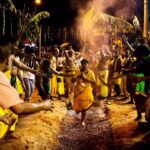Classical dance in India is a vibrant tapestry woven with centuries-old traditions, cultural nuances, and exquisite movements. Each region of the country boasts its own distinct style, reflecting the rich diversity and heritage of Indian classical dance forms. From the graceful movements of Bharatanatyam to the storytelling gestures of Kathak, classical dance in India is a mesmerizing art form that transcends time and space.
Bharatanatyam:

Bharatanatyam, one of India’s oldest and most respected classical dance genres, originated in the temples of Tamil Nadu. Characterized by its intricate footwork, expressive hand gestures (mudras), and emotive facial expressions, Bharatanatyam is a celebration of devotion, spirituality, and storytelling. The dance repertoire typically includes a combination of nritta (pure dance), nritya (expressive dance), and natya (dramatic storytelling), making it a complete art form that captivates audiences worldwide.
Kathak:

Hailing from the northern regions of India, Kathak is a dynamic and expressive dance form that traces its roots to the ancient courts of Mughal emperors. Known for its graceful movements, intricate footwork, and improvisational techniques, Kathak is characterized by its emphasis on storytelling through rhythmic patterns (tukras), intricate spins (chakkars), and expressive gestures (abhinaya). With influences from Persian, Hindu, and Muslim cultures, Kathak is a beautiful amalgamation of tradition and innovation, captivating audiences with its fluidity and grace.
Odissi:

Originating from the state of Odisha, Odissi is a classical dance form that celebrates the divine love of Lord Jagannath and Radha-Krishna. Known for its lyrical movements, sculptural poses (bhangis), and fluidity of expression, Odissi is a visual feast that transports audiences to the mystical realms of ancient mythology and folklore. With its roots in temple rituals and devotional practices, Odissi is a spiritual journey that embodies grace, beauty, and devotion, captivating audiences with its mesmerizing rhythms and evocative storytelling.
Kuchipudi:

Hailing from the southern state of Andhra Pradesh, Kuchipudi is a classical dance form that combines graceful movements, rhythmic footwork, and vibrant storytelling. Originating from the village of Kuchipudi, this dance form has its roots in ancient Sanskrit texts and classical music traditions. Characterized by its dynamic energy, intricate footwork, and expressive gestures, Kuchipudi is a celebration of life, love, and mythology, enchanting audiences with its colourful costumes, lively music, and dynamic performances.
Mohiniyattam:

Originating from the state of Kerala, Mohiniyattam is a classical dance form that celebrates the divine beauty of the enchantress Mohini, an avatar of Lord Vishnu. Known for its graceful movements, gentle swaying, and fluid gestures, Mohiniyattam is a mesmerizing blend of poetry, music, and dance. With its emphasis on storytelling through expressive abhinaya (facial expressions) and delicate movements, Mohiniyattam is a captivating art form that embodies the essence of femininity, grace, and allure.
Manipuri:

Hailing from the northeastern state of Manipur, Manipuri is a classical dance form that celebrates the rich cultural heritage and traditions of the region. Known for its lyrical movements, graceful gestures, and intricate footwork, Manipuri is a visual spectacle that transports audiences to the mystical realms of ancient mythology and folklore. With its roots in devotional practices and ritualistic traditions, Manipuri is a spiritual journey that embodies beauty, grace, and divine love, captivating audiences with its enchanting rhythms and evocative storytelling.
Each classical dance style in India is characterized by its unique repertoire of movements, gestures, costumes, and music, reflecting the distinct cultural traditions and regional influences of its origins. Whether it’s the intricate footwork of Kathakali or the graceful hand movements of Mohiniyattam, classical dance in India is a testament to the country’s diverse cultural heritage and artistic brilliance.
Classical dance in India is not just a form of artistic expression; it is a way of life deeply rooted in the cultural fabric of the country. Passed down through generations, classical dance forms serve as a repository of traditional knowledge, historical narratives, and spiritual wisdom, embodying the essence of India’s rich cultural heritage.
Furthermore, classical dance forms play a significant role in promoting cultural exchange and fostering understanding among diverse communities. Through performances, workshops, and collaborative projects, dancers and choreographers strive to bridge cultural divides and promote cross-cultural dialogue, enriching the global tapestry of human expression.
In addition to its cultural significance, classical dance in India also holds economic importance, contributing to the country’s tourism industry and generating employment opportunities for dancers, musicians, costume designers, and other professionals. Festivals, dance academies, and cultural institutions dedicated to classical dance further promote the art form, attracting enthusiasts and scholars from around the world.
Conclusion
Indian classical dance is a treasure trove of artistic expression, cultural heritage, and spiritual devotion. From the graceful movements of Bharatanatyam to the storytelling gestures of Kathak, each classical dance form in India is a testament to the rich tapestry of traditions, customs, and beliefs that define the country’s cultural landscape. As custodians of this ancient art form, dancers across India continue to preserve, promote, and innovate classical dance, ensuring that it remains a vibrant and integral part of India’s cultural identity for generations to come.







